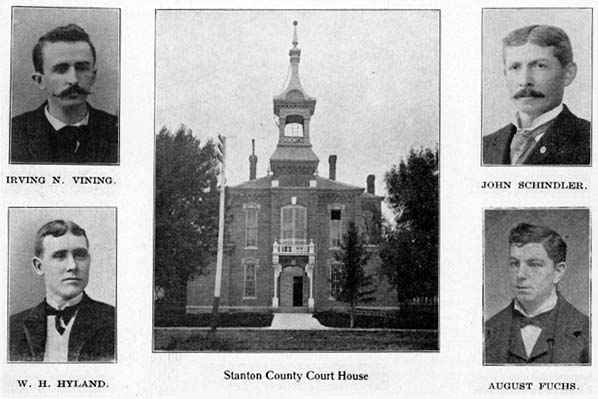Lacy settled in Sioux County, Nebraska, in 1897.
He took a homestead here, but has been engaged in the
livery business. He was married in 1900 to Miss Mabel
Lowry of Harrison,. Nebraska, and they have one, son. His
father took a homestead in Sioux County in 1895. Mr. Lacy
is a Democrat and is serving his second term as Deputy
Sheriff of this county.
CONRAD PARSONS
was born in Clearwater, Nebraska, October 6, 1880, where
he lived until his fifth year, when he came to Sioux
County with his parents, his father having homesteaded
and gone into ranching in this county. He attended
Chadron Academy and the Wesleyan University, graduating
from the Business Department of the latter institution in
1901. He took a homestead in Sioux County under the
Kinkaid law and has a ranch stocked with about one
hundred head of cattle. Mr. Parsons is a Republican, has
been County Superintendent of Sioux County and is now
serving his. second year as Deputy County Clerk.
STANTON COUNTY.
About two-thirds
of the inhabitants of Stan ton are foreigners. The first
foreign element consisted of Germans, who settled on the
Humbug in the fall of 1865. The early settlers comprised
people from Wisconsin, Indiana, Iowa, Ohio, Illinois and
New York. In 1881 the census showed 1,994 people, of
which 700 were school children. The last census gives
6,959 people and 2,699 school children. Stanton, the
county capital, is populated by 1,052 people. There are
fifty-five school districts and an equal number of
buildings, all of which are well furnished with supplies.
The entire school property is estimated at $48,391.81.
The majority of the schools have a term lasting six to
nine months. Stanton County was organized in 1867 and is
one of the smallest in the state, being 432 square miles
in area. The first settlers were Charles and Mitchell
Sharp, who staked out their claims in the summer of 1865
on Humbug Creek, after which they returned to Omaha. The
Scott and Hoffman families came next, and they also chose
a location on this creek. In 1869 George Graves started
the first county store in this settlement. Ida Hoffman,
born in 1867, was the first native of Stanton County.
Lewis Ley, who came in 1871, was the first lawyer. The
first fee he received was five pounds of sausage in
return for clearing a client. The numerous streams cause
a great variety of soil throughout the county, although a
rich, black loam is the predominating kind. Eighty-six
per cent is tillable, while the rest comprises a sandy
strip south of the Elkhorn. The people are engaged in
stock raising and mixed farming. There are 1,123 farms,
and a large amount of money is expended in implements and
machinery. The value of land has doubled within the past
few years.
AUGUST FUCHS was
born in Germany, July 1, 1860. He came to Monee, Will
County, Illinois, in 1866 and in the fall of 1870 removed
with his parents to Fremont, Nebraska. . He attended the
Fremont public schools and the Fremont Normal, moved to
Stanton, Nebraska, in 1889 and engaged in the hardware
business. He was elected County Treasurer of Stanton
County in 1901 and re-elected to that office in 1903.
W. T. McFARLAND
was born in Indianapolis, Indiana, January 10, 1845, and
came to Stanton County in 1868. He served three years in
Company K, Tenth Indiana Infantry, and in 1873 married
Miss Adeline Robinson. He is affiliated with the
Republican party and has held the office of Postmaster
practically from 1881 to 1893, also Deputy Sheriff from
1898 to 1900. He is serving as Clerk of the District
Court of Stanton County.
W. H. HYLAND was
born in Dodge County, Wisconsin, October 23, 1868. In
1900 Mr. Hyland settled in Stanton and on January 1,
1903, married Miss Angie M. Beard. He was educated in the
Fremont Normal and the Omaha Commercial Schools and took
postgraduate work in the Fremont Normal in 1895 and 1896.
He is a member of the Democratic party and is now serving
his second term as County Superintendent.
ALBERT PILGER,
the County Clerk of Stanton County, was born August 31,
1876, at Stanton, Nebraska. He is a merchant at Pilger,
Nebraska, and his father, Adam Pilger, was an early
settler, coming here about 1870. He was also a merchant
and was Treasurer of Stanton County for two terms. Mr.
Pilger is a Democrat and was married to Pauline Newman
June 2, 1903.
|




